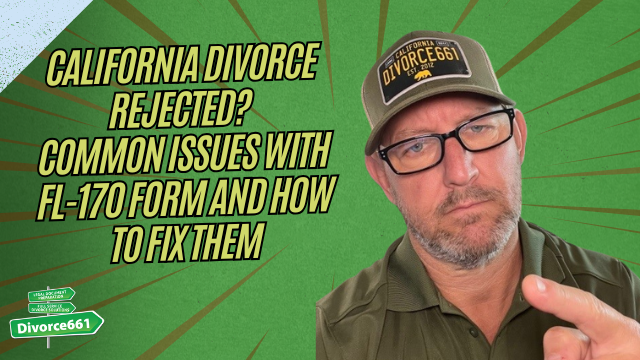California Divorce Rejected? Common Issues with FL-170 Form and How to Fix Them
If you’re navigating a California divorce and find your judgment rejected, one common culprit could be the Judicial Council Form FL-170, also known as the Declaration for Default or Uncontested Dissolution. This form is a mandatory piece of the puzzle when submitting your divorce judgment, yet it’s often overlooked or filled out incorrectly, leading to delays and frustration.
Tim Blankenship from Divorce661 breaks down why FL-170 is so important, what it entails, and how to avoid common mistakes that cause your divorce judgment to be rejected. Whether you’re the petitioner or respondent, understanding this form can save you time and help your case move smoothly through the court system.
What is Form FL-170 and Why Is It Mandatory?
Form FL-170 is a three-page declaration that must accompany your divorce judgment submission. It informs the court about the nature of your case — specifically, whether your divorce is a default without agreement, a default with agreement, or an uncontested dissolution. This procedural form is essential because it clarifies the status of your case for the judge reviewing your paperwork.
Only one FL-170 form is required per case, meaning either the petitioner or respondent completes and signs it, but not both. This keeps the process straightforward and helps avoid duplication.
Common Reasons FL-170 Causes Divorce Judgments to Be Rejected
Despite its simplicity, FL-170 is a frequent reason for rejection. Here are the most common issues:
- Missing Signature: The form must be signed by the person submitting it. An unsigned FL-170 is automatically rejected.
- Incorrect or Missing Notarization: If you have a settlement agreement, both parties’ signatures often need to be notarized. Failing to do this properly can cause rejection.
- Wrong Box Checked: The form requires you to indicate the type of divorce case (default, default with agreement, uncontested). Marking the wrong box or leaving it blank confuses the court about your case status.
These errors are easy to fix but are critical to get right to avoid delays in finalizing your divorce.
How to Correctly Fill Out Form FL-170
Filling out FL-170 is relatively straightforward, but attention to detail is key. Here’s a quick guide:
- Confirm the Case Status: Identify if your case is a default without agreement, default with agreement, or uncontested dissolution and check the appropriate box.
- Verify All Statements: The form asks if the information in your petition is true and whether spousal support is involved. Answer these honestly and accurately.
- Sign the Form: Ensure the person submitting the form signs it. Remember, only one signature is needed on the FL-170.
- Notarize if Required: If your case includes a settlement agreement, make sure signatures are properly notarized to avoid rejection.
Completing these steps carefully will help your judgment pass court review without unnecessary setbacks.
Additional Resources for DIY Divorce Filings
If you’re handling your divorce paperwork yourself, having a reliable checklist and tutorial can make a huge difference. At CaliforniaDivorceTutor.com, you can find comprehensive checklists tailored to your specific divorce style, including all required forms like FL-170. These resources walk you through each step, helping you avoid common pitfalls that lead to rejected judgments.
Whether you’re just starting your divorce process or correcting errors after a rejection, reviewing your documents thoroughly with these tools can save time and reduce stress.
Conclusion
In California divorces, the FL-170 form is a small but critical part of the judgment submission process. Missing it, submitting it unsigned, or incorrectly filling it out are the main reasons courts reject divorce judgments. Taking the time to understand this form, fill it out correctly, and use available resources like checklists can help your case move forward smoothly.
Remember, only one FL-170 is needed per case, and it must clearly state the type of divorce you’re filing. Pay close attention to signatures and notarization requirements, especially when a settlement agreement is involved.
If you want a step-by-step guide on completing FL-170 and other divorce forms, check out the tutorials at CaliforniaDivorceTutor.com. With the right preparation, you can avoid common errors and get through your divorce process more efficiently.
Thanks for reading, and best of luck with your divorce journey.

